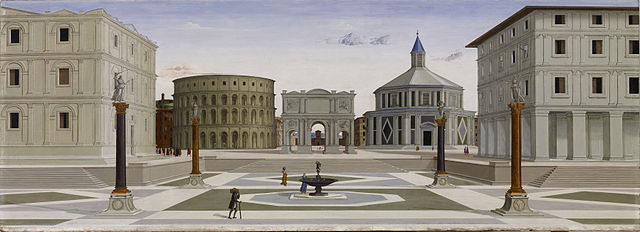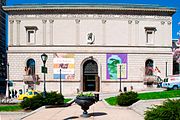
File:Fra Carnevale - The Ideal City - Walters 37677.jpg

Size of this preview: 640 × 232 pixels.
| |
This is a file from the Wikimedia Commons. Information from its description page there is shown below.
Commons is a freely licensed media file repository. You can help. |
Summary
| Artist |
|
|||||||||||||||||
| Title | The Ideal City | |||||||||||||||||
| Description |
English: This extraordinary panel exemplifies Renaissance ideals of urban planning, respect for Greco-Roman antiquity, and the mastery of central perspective. The imaginary city square features a Roman arch typically erected as a commemoration of military victory at its centre. As a whole, the painting offers a model of the architecture and sculpture that would ideally be commissioned by a virtuous ruler who cares for the welfare of the citizenry. The amphitheater is modeled on the Colosseum in Rome. The octagonal structure to the right, covered with colored stone, suggests the medieval Baptistery in Florence, which in the 15th century was thought to be a reused Roman temple. Together they reflect the importance of security, religion, and recreation in a well-regulated city and the value of Roman ideals in urban design. The private residences at either side are also dignified with classical architectural elements. Classicizing elements also appear in the foreground. Statues, set on columns in the Roman style, represent virtues of a good ruler, including Justice with her sword and scales and Liberality (generosity) with a cornucopia. This view and two related paintings (now in Urbino and Berlin) were apparently commissioned for the palace of Duke Federico da Montefeltro of Urbino. Set into the woodwork at shoulder height or higher, "The Ideal City" would have seemed like a window onto another, better world. The illusion of a space that extends out from our own is achieved using a mathematical perspective system developed in Florence. The space is defined in terms of the viewer's own angle of vision: the receding lines establishing spatial relationships converge at a central point in the city gate visible beneath and beyond the Roman arch.
|
|||||||||||||||||
| Date | between circa 1480 and circa 1484 | |||||||||||||||||
| Medium | oil and tempera on panel | |||||||||||||||||
| Dimensions |
|
|||||||||||||||||
| Current location |
|
|||||||||||||||||
| Accession number | 37.677 | |||||||||||||||||
| Object history |
|
|||||||||||||||||
| Credit line | Acquired by Henry Walters with the Massarenti Collection, 1902 | |||||||||||||||||
| References | Federico Zeri (1976) (in English) Italian paintings in the Walters Art Gallery, Baltimore: Walters Art Gallery, no. 96, pp. 143-151 OCLC: 2463997. | |||||||||||||||||
| Source/Photographer | Donated by the Walters Art Museum as part of a cooperation project | |||||||||||||||||
| Permission ( Reusing this file) |
|
|||||||||||||||||
Licensing
 |
This file was provided to Wikimedia Commons by the Walters Art Museum as part of a cooperation project. All artworks in the photographs are in public domain due to age. The photographs of two-dimensional objects are also in the public domain. Photographs of three-dimensional objects and all descriptions have been released under the Creative Commons Attribution-Share Alike 3.0 Unported License and the GNU Free Documentation License. In case of the text descriptions, copyright restrictions only apply to longer descriptions which cross the threshold of originality.
|
This digital reproduction has been released under the following licenses:
|
||||||||
File usage
The following pages on Schools Wikipedia link to this image (list may be incomplete):
The best way to learn
Through Schools Wikipedia, SOS Children has brought learning to children around the world. SOS Children helps more than 2 million people across 133 countries around the world. Sponsoring a child is a great way to help children who need your support.


